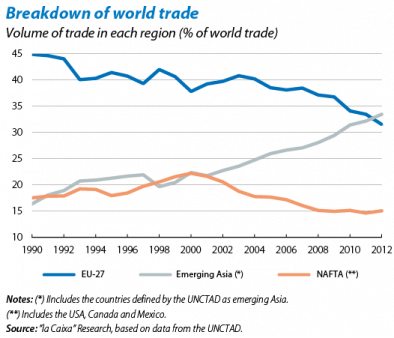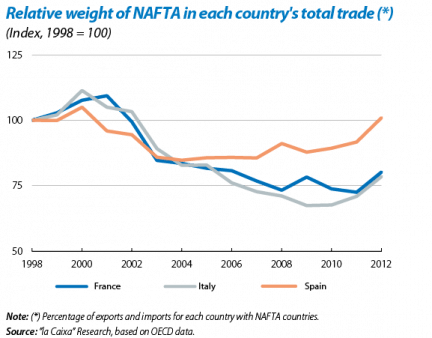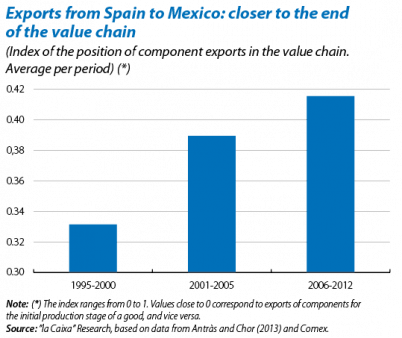Spain and Mexico: two trading partners with a promising future
The foreign sector has been one of the key players in the incipient recovery of the Spanish economy. The prominent performance of exports has gone hand in hand with a hardly noticed structural change, namely the significant increase in the geographical diversification of exports. Spain's main trading area is still Europe. However, two large trading areas, that of the North American Free Trade Agreement (NAFTA) and emerging Asia, have gained in importance over the last few years. This Dossier analyses the diversification of Spanish trade both quantitatively and qualitatively, paying special attention to Spain's relationship with Mexico, one of the gateways to NAFTA.
At a global level, the relative weight of the large trading blocs has dramatically changed in the last decade. For example, in 1995 45% of world trade took place in the European Union while the volume of trade taking place in the NAFTA countries and emerging Asia accounted for, approximately, 17% each. Nonetheless, the centre of gravity of world trade has significantly shifted, with emerging Asia already taking over the lead position in 2012 with 33% of world trade.
In line with this rearrangement of commercial flows at a global level, Spain has also diversified its trading partners. The European Union is still the main destination for Spanish exports but its importance has shrunk considerably (68% in 1998 vs. 54% in 2012). We can better contextualise this change by comparing it with the change taking place in relatively similar countries such as France and Italy. The increase in exports to emerging Asia has been similar in all three countries while the decline in the weight of exports to the EU has been particularly marked in Spain. This is largely due to the fact that Spain's share of exports to the NAFTA area has remained almost constant while it has fallen in both France and Italy. It is worth mentioning the dynamism of Spansh exports of goods to Mexico which, on average, grew by 15% year-on-year in nominal terms between 2000 and 2010.
In addition, Spanish exports are becoming more integrated within the so-called «global value chain», and Spain's relationship with Mexico plays an important role in this aspect as well. Let's look at this step by step. The global value chain has emerged particularly because of the revolution in information technologies. The production of the iPhone, created and designed in Palo Alto but manufactured in China using components imported from other Asian countries, is a typical example of this. Spain plays an active and important role in the global value chain. Specifically, according to estimates by the United Nations Conference on Trade and Development (UNCTAD), Spain's exports and imports used as inputs for the production of goods account for 45% of all Spanish exports. This number is very similar in the USA but lower in Germany (64%) and France (63%).
Spain's involvement in the global value chain is fundamentally via trade with other European countries: the inputs used by Spanish exports come mostly from other EU countries. Similarly, EU countries are the main users of exports of Spanish inputs. The only non-European country that significantly uses Spanish inputs for its exports is Mexico (1% of exports). This share is very far from the 37% of the USA but is still remarkable.
Even more important than Spain's degree of participation in the global value chain is the kind of goods imported and exported by Spain. It is not the same thing to be part of the early part of the value chain, exporting raw materials to manufacture the components of the iPhone, for example, as being at the end, which is where most of the value added is concentrated. In this respect, exports from Spain to the EU are at the end of the assembly chain while those to Asia and the NAFTA countries come halfway.(1) These findings reflect the comparative advantage of emerging countries in unskilled labour-intensive industries, which tend to be located at the initial end of the assembly chain.
On average, the type of goods exported by Spain to Mexico over the last few years is similar to that of the NAFTA as a whole, but the composition of these exported goods has changed quite considerably.(2) Between 1995 and 2000, the exported goods were located at the beginning of the value chain but, over time, these exports have gradually moved to a more intermediate position in the value chain (see the graph on the right), a position that tends to be associated with goods of a higher value added.
The focus of Spanish export firms on Mexico is not only reflected in the growth in exports or the change in the type of goods but also in the flows of direct investment towards this country, which have been substantial. Actually, Spain is the third country with the highest cumulative foreign direct investment (FDI) in Mexico, 12.8% of the total. Moreover, this focus on Mexico is not only a trend in Spain. Indeed, Mexico is the seventh most popular destination in the world for FDI according to the UNCTAD, after China, the USA, India, Indonesia, Brazil and Germany.
To conlude, the growing importance of Spain's foreign sector hides a gradual but far-reaching transformation in productive capacity. Spanish exports are becoming increasingly integrated within the global production chain and have more diversified partners. Mexico plays a fundamental role in this transformation: as a gateway to one of the major trading areas. In this respect, the structural reforms being carried out in the Aztec country lead us to believe that this gateway will increasingly open up. Therefore, the commercial relationship between Spain and Mexico, which is already good, has a promising future.
Sergi Basco, Philipp Hauber and Oriol Aspachs
European Unit, Research Department, "la Caixa"
(1) Antràs, P. and Chor, D. (2013), in «Organizing the Global Value Chain», Econometrica 81(6): 2127-2204, calculate an index for the position occupied in the assembly chain by each industry. For example, petrochemicals and the copper industry are at the beginning of the assembly chain and therefore have low indexes (0.21 and 0.23 respectively) while industries closer to the end consumer, such as automobiles or furniture, have higher values (0.99 in both cases). The index is calculated for manufacturing industries and excludes R&D.
(2) Only the exports of intermediate goods should be taken into account to determine the position in the assembly chain occupied by Spanish exports contained in Mexican exports. However, as these figures are not available, we have used the total exports, which include finished goods.





